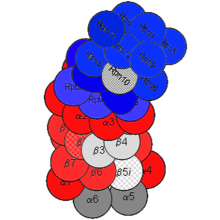
Cancer cells can be highly dependent on specific nodes of the protein homeostasis network. This dependency can be exploited therapeutically. The defining example is multiple myeloma, a common blood cancer. Myeloma cells are hypersensitive to inhibition of the proteasome, which degrades cellular proteins. While drugs inhibiting the proteasome were a big breakthrough in myeloma therapy, most patients eventually develop drug resistance and relapse.
We used our functional genomics platform to identify genes controlling the response of myeloma cells to proteasome inhibitors. Knockdown of specific other nodes of the proteostasis network further sensitized cells to proteasome inhibitions. These nodes are potential combination therapy targets in myeloma.
A major surprise was the effect that levels of different subunits of the proteasome had on drug sensitivity. While decreasing the levels of catalytic (20S) subunits sensitized cells to the drug as expected, decreasing the level of regulatory (19S) subunits paradoxically made the cells resistant to the inhibitors. Intriguingly, lower levels of regulatory proteasome subunits also desensitized multiple myeloma patients to therapy based on proteasome inhibition, suggesting that results from the genetic screen carried out in cells can predict clinical resistance mechanisms and guide the development of future therapies to increase patient survival.
The collaborative project was published in eLife:
Acosta-Alvear D, Cho MY, Wild T, Buchholz TJ, Lerner AG, Simakova O, Hahn J, Korde N, Landgren O, Maric I, Choudhary C, Walter P, Weissman JS, Kampmann M (2015) Paradoxical resistance of multiple myeloma to proteasome inhibitors by decreased levels of 19S proteasomal subunits. eLife 10.7554/eLife.08153
